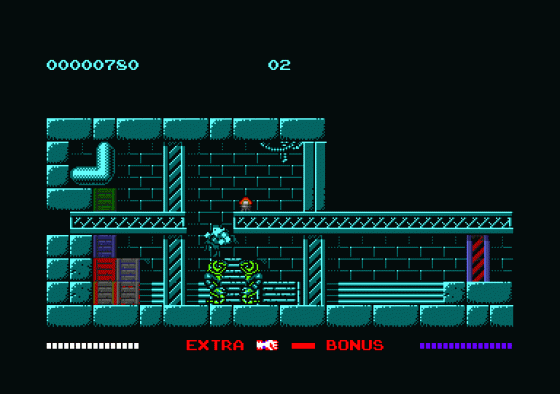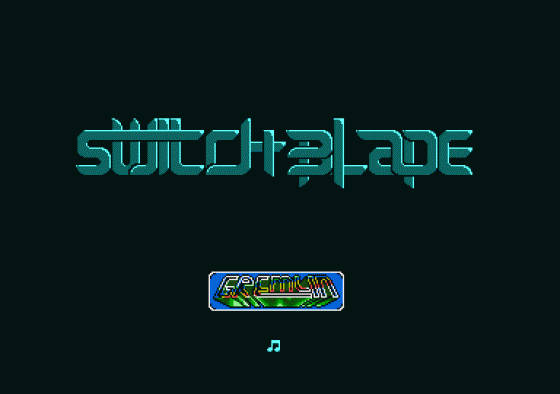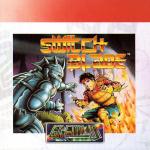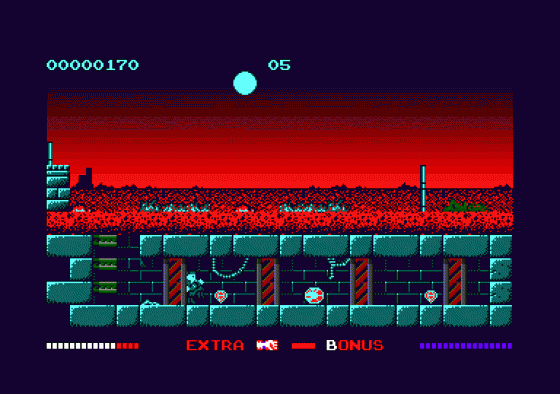
Amstrad Action
 1st January 1991
1st January 1991
Categories: Review: Software
Author: James Leach
Publisher: Gremlin
Machine: Amstrad CPC464+/GX4000
Published in Amstrad Action #64
Stunner
Switch Blade
Hiro is the last of the Bladeknights, a trained warrior with a hi-tech re-programmable cyber-arm which can accept any number of different and ever more destructive weapons. He can also kick and punch hard enough to demolish walls and leap huge distance with one thrust of his mighty limbs. He's also about three feet tall, shaped like a seven-year-old Schwarzenegger and wears his cap back to front. We won't worry about that, though.
Needless to say, Hiro has a rather important task to perform. Namely, to rid the world of Thraxx of the evil Havok, who has dominated the world since the shattering of the Fireblade (you are paying attention, aren't you?). As Hiro, you must explore the Undercity beneath the surface of Thraxx, battling Havok's evil and ghastly minions and assembling the bits of the Fireblade so that you can use it against the evil geek himself.
OK, never mind the scenario, let's get cracking... oh, is that it? Hmm, click past the opening text screens and your first glimpse of the game itself is worrying. Um, the graphics only take up half the screen, and, er, there's only one colour, if you don't count black and white...

Yes, well, let's not worry about the graphics for a moment - what does it play like? Well, Hiro's a game little chap. Admittedly, there's no great urgency about his walk - more like somebody pushing a trolley around Waitrose than battling his way to a confrontation with an evil megalomaniac. However, he is nimble enough in a tight corner, delivering devastating low kicks, high kicks and punches on demand and leaping huge gaps (with an appropriate run-up).
You start out on the surface of Thraxx and can travel either left or right. Left will take you - via a nasty creature and some nasty flames - to a hole in the ground you don't see until you step onto it (depending on whether you can step on something that only exists because it isn't there, er, um...). Suddenly you're in a different - underground - world. So this is where all the colours are! Yup, once you're underground, Switchblade suddenly looks a whole lot better.
Hiro starts out with five lives and a full complement of vitality. If he gets hit by a monster, though, his vitality bar starts shrinking. When it gets to zero, he loses a life. To combat the various monsters he'll encounter, Hiro can deliver low kicks, high kicks and punches. It all depends on how long you keep the Fire button pressed. Let it go almost immediately and Hiro delivers a jab to the forehead. Keep it pressed a moment longer and he launches a boot at the enemy's visage, keep it pressed until your 'kickometer' (bottom of the screen) reaches maximum and you can kick the other guy's legs off. Brilliant!

Switchblade is basically a Rick Dangerous-style game, where you must explore the underground corridors, avoiding traps and dealing with various nasties on the way. Unlike Rick Dangerous, however, you can't actually 'see' a room until you go into it. So, as you're exploring, you really are in the dark - and that adds a great deal to the game. Switchblade doesn't have Rick's humour, either, or its range of puzzles, but it makes up for it with a wide variety of evil beasties and a whole host of collectable weapons and bonuses. Given this range of weapons and opponents, Switchblade is as much a kick-'em-up as an exploration game, but some of those puzzles are really very subtle, particularly as you can come at many of them from different directions.
If Switchblade's graphics take a while to impress, the same can be said of the gameplay. It starts off seeming a bit easy and shallow, but gradually escalates into a very impressive and challenging game indeed. In terms of size, it's a monster. With a total of over 150 screens to explore, you're talking about one huge game area.
The graphics themselves really are very good indeed. Although it's all in four-colour mode, the programmers have used split-screen techniques to bump up the colour count right from the start. And there are enough hardware sprites in there masquerading as background detail to push up the number of on-screen colours to nearer twenty than four. Combine that with the high resolution of Mode 1 and you've got a console game that looks like it's playing on a 16-bit. (In fact, although the ST version's sprites are better, the Amstrad's backgrounds are miles ahead of the 16-bit machine's!)
The soundtrack plays continuously, and is original and listenable. There are no sound effects, but that doesn't take much away from the game.
For Gremlin to use the four-colour mode on the console - especially when people are expecting spectacular new standards of graphics - is a brave choice, but once any initial disappointment has worked off, the overwhelming impression is of very subtle, and very, very good visuals which really do make the best of the new hardware. The other striking thing about the game is its sheer size - it just goes on and on! And the further you go, the better the puzzles, the enemies and the fun factor.
If Burnin' Rubber on the console set new standards for driving games, then Switchblade does the same for platform adventures. It may not grab you by the short 'n' curlies straight away, but it slowly, inevitably, sucks you in until you simply can't leave it alone. What an excellent game!
First Day Target Score
Find three Fireblade bits.
Switchblade Tips
- When you can, jump onto a crate before taking on the enemy. Most can't hurt you while you stand one level above them, but you can merrily kick their tights out.
- When entering a screen, wait for the monsters to appear. Note the point at which they generate for future reference. Try to take them on one at a time and try to get them all. Once all the monsters on a screen are dead they don't regenerate, even when you come back later.
- Take careful note of which weapon you're carrying. You can only repeat-fire after your last missile has exploded and some traverse the entire length of the screen, making them useless in close-combat.
- Avoid stepping off into space without knowing what's below. There are some stages in the game which involve large falls, and this can sap your vitality badly.
- Look out for where the vitality power-ups can be found. Plan your movements so that you pick up the energy when you most need it.
- You only jump a short distance if you leap from a standing position. Take a run-up to jump further.
- If a monster appears at an awkward placetime when you enter a screen, leave it immediately and try coming back.
- Monsters always home in on you, so use the platforms and different floor levels carefully to get them into the position you want, when you want.
- The boss monsters have particular movement and firing patterns. You'll iose energy sussing them out but once you have even these monsters will (should!) prove easy meat.
- To make sure you're not missing out any bits of Fireblade, map the game as you go along. It'll pay off far better than simply trying to do it from memory, and you will find some safer short-cuts round some puzzles.
- Remember, there is no time limit, so you can analyse a problem for as long as you like.
- If you come up against a brick wall (literally), look carefully for square bricks showing more detail than the rest - you can kick these away.
Technically Speaking
After playing Switchblade for a few days, we were so impressed we took Gremlin's technical guru James North-Hearn to one side and gave him a grilling...
Q. We've got Switchblade now, we've been playing it for a few days, and we think it's really good.
A. Yes, we're really pleased with it.
Q. It's a very big game, as well, isn't it?
A. It's a massive game - there's an awful lot in there.
Q. Now we understand that you've used the hardware sprites to actually add more colours for the backgrounds?
A. We went to 4-colour mode because we felt that because of the size of detail, in the 16-colour mode it would not have looked anywhere near as impressive as it does. We used the stippling effect to add shading etc, which I think you'll agree works. Because we went to 4-colour mode we wanted to add more colour, so there's already - without any hardware sprites or anything - there's already two splits in it, which are noticeable at the top and bottom. And I think at most times we have at least six colours on and sometimes eight colours on screen. By splitting the screen and changing the palette, at the top, the play area and the bottom - if you count the colours you'll see there's always more than four.
Because down at the bottom you've got a blue and a red, then you've got all the colours within the game. And there's also sometimes a different colour at the top. So that's easy to implement on the console. In addition to that, we added colour to the back-grounds by actually making the backgrounds out of the 16-colour sprites. So we built up the backgrounds with normal background techniques, but also added hardware sprites to add colour throughout the game.
Q. So the sprites are in 16-co!ours, but you get higher resolution for the sprites, don't you, than in normal 16-colour mode in the backgrounds...?
A. What we didn't do is make very elaborate sprites, really big ones, and just plonk them on the screen for the sake of it, because that would have ruined the look of the game. The sprites are actually in key with the rest of the game. They fit. You can't tell they're in any way different from the backgrounds except that they're colourful. We've put sprites on every screen, so every screen contains well in excess of the normal four colours.
Q. The thing is, we also took a look at the ST version - and we've been having a bit of a debate with the ST Format lads - but we actually reckon that the console version is better...
A. ...Slightly better, yeah! What do you think?
Q. What do you think?
A. For a start off, the product makes a very good console type of game. That's one of the reasons you think it is better, because on the ST you're aiming - in a sense - to do a different kind of thing.
Q. Does this game format lend itself to the console hardware, is that what you're saying?
A. Let's put it this way. The console hardware is such that we can implement that type of game as well - if not better - on the console than we can on the ST.
Q. Is that because of things like the hardware sprites?
A. Yes. That's because the hardware sprites enable us to put more colours on. Also -although in this game we don't scroll the backgrounds - if we had gone to a scrolling design, obviously the console would have been able to handle that as well. We think it came out as well on the Amstrad as a product as it did on the ST. I think the thing you have to remember is we had hindsight as well. We were able to tweak any parts that we wanted to tweak because we'd already produced the ST version. But I wouldn't disagree with you. I think, up against the two, if I could play either one of them, I would probably be more likely to play the Amstrad console version.
Well there you go - straight from the horse's mouth! Er, no offence, James...
Other Reviews Of Switch Blade For The Amstrad CPC464+/GX4000
Cartridge Round-Up
It's been over 18 months since the Amstrad Plus and GX4000 were unleashed on an unsuspecting public. Twelve games were supposed to be available as the machine hit the streets. Many more were promised for the months to come. But the machines flopped. Was it because the software was crap... or because you couldn't get it? Rod Lawton checks out all those cartridge games and reaches a conclusion...
Switchblade (Gremlin)
Having a robotic arm with interchangeable appendages is all very well, but has Switchblade's hero got an attachment for getting stones out of hooves?
Switchblade (Gremlin Graphics)
A review






